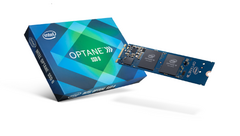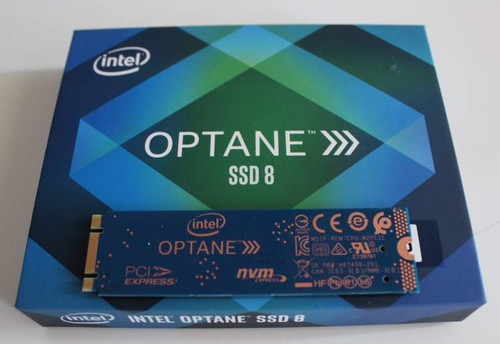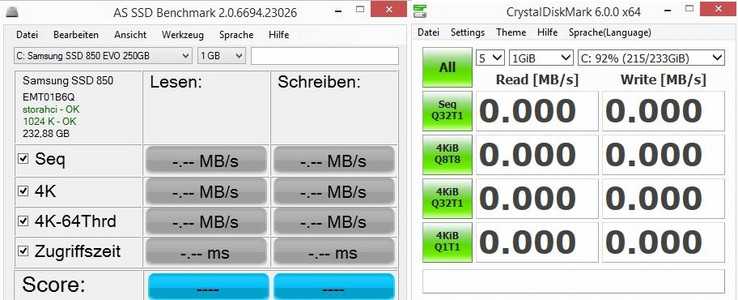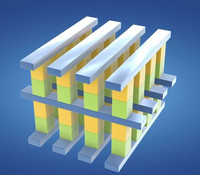Intel Optane 800P
Early in 2017, Intel introduced the first 3D XPoint storage for consumers. At the time, it only consisted of 16 and 32 GB memory modules that could serve as cache to speed up boot time for the operating system and programs.
One year later, Intel is bringing two M.2 cards to the market—both versions of the Intel Optane SSD 800P. One offers 58 GB of storage space; the other 118 GB. Both are at least large enough for the computer's operating system. The storage technology is fundamentally different from the NAND cells used in SSDs and is designed to offer an especially high constancy of performance. In addition, the random data transfer rates are extremely fast.
Both cards have a nondescript appearance; Intel has chosen to forgo flashy logos and coolers. The PCIe 3.0 cards are 22 mm (~0.87 in wide and 80 mm (~3.1 in) long (M.2 2280). They are linked over just three lanes—more would be unnecessary given that three theoretically allow for a transfer rate of up to 2000 MB/s, and Intel specifies the maximum sequential transfer speed at 1450 MB/s. The NVMe interface protocol is used to transfer data.
Benchmarks
For this relatively short review, we tested the Intel Optane SSDs' potential performance capabilities with the help of AS SSD and CrystalDiskMark. Both programs measure the performance capacity of storage media. With the exception of the AS SSD copy test, all of these benchmarks are synthetic.
A variety of factors must be taken into account when using these measurements; it is always necessary to run synthetic benchmarks multiple times. These tests also require the experimenter to pay close attention to the card's thermoregulation, as many modern SSDs throttle during long periods under load in order to avoid overheating. To identify and approximately quantify the medium's thermoregulation, we use CrystalDiskMark to write data to the drive that we are testing in total volumes of 5, 18 and 288 GB. We pause for five seconds in between each individual write interval.
Here we evaluate the Optane SSD 800P's performance in comparison to that of the Samsung SSD 970 EVO and the Intel SSD 760p. In principle, it would be possible to compare these drives to older SSDs that we have tested—especially the earlier Optane products—but the Meltdown and Spectre patches that we would need to activate may eat up a significant portion of the older drives' performance power, rendering the comparison only possible to a limited extent.
Comparison between 118 GB and 58 GB models
The comparison between the two different storage capacities did not produce any particularly surprising results—the superior performance power of the two-times larger model is visible in every test scenario, but not drastically higher. We see a similar trend in classic SSDs, though the gain in performance resulting from greater storage capacity is generally significantly more pronounced.
Comparison with the Samsung SSD 970 EVO and the Intel SSD 760p
CrystalDiskMark
The popular CrystalDiskMark benchmark software reveals that the two SSDs that we tested for comparison purposes—the 970 EVO (500 GB) SSD and the 760p (256 GB) SSD—reach sequential data transfer rates around twice the speed of the two Optane models. Even so, from an absolute perspective, the results from the Optane devices are not bad; 1453 MB/s reading and 644 MB/s writing actually slightly exceed the manufacturer's specifications.
Unsurprisingly and in keeping with the promises of the new technology, the superiority of the NAND SSDs is relativized when it comes to random data transfer: While the NAND SSDs can outdo the Optane models when using multiple threads and a long queue, at a queue depth of 1 the Optane SSD 800P is substantially faster. The lower queue depth is significantly more relevant to practical use, though a noticeable increase in speed cannot be expected in everyday circumstances. Even in trace benchmarks, the differences are hardly of consequence.
In terms of constancy of performance, we do have positive results to report: Even after more than 300 GB, the sequential data transfer rates remain constant—provided that the drives are given a five-second pause after each 32 GB chunk.
AS SSD
The fully synthetic AS SSD benchmarks corroborate the results from CrystalDiskMark, especially the Optane drives' significantly higher performance power in random file operations without a queue. Put simply, the drives get going quicker.
The copy benchmark is more relevant to everyday use, but ultimately also synthetic. It measures the transfer speeds of three different data packages. Large files are transferred in the ISO test; the program test is based on the transfer of many smaller files; and a mixture of big and small files are transferred in the gaming benchmark.
The Optane drives certainly do not make a name for themselves on the basis of their results here. Especially compared to the Samsung SSD 970 Evo, they lag substantially behind. Striking, however, is the Optane drives' high level of consistency throughout all three scenarios. While the classic SSDs' performance in the program test nosedives by a margin of two-thirds in the most extreme case, the Optane drives show no sign of struggle.
Verdict
In principle, Intel is once more putting the potential of their 3D XPoint technology on display. But that "once more" is precisely the problem with the Optane 800P— the technology offers a high level of data consistency and unrivaled data transfer speeds for random file operations, but the latter advantage is hardly reflected in even the most specialized benchmarks; no benefit is to be expected in everyday use.
A concrete purchasing decision can only be made in light of cost, especially given that there are many good and very good SSDs from mainstream manufacturers on the market right now. But price is a problem: Intel is displaying an extraordinary level of confidence with their price tag of 200 Euros (~230; US version ~$200). For the same fistful of cash, potential buyers could opt for a 500 GB Samsung 970 Evo, for example.
Test System
In our tests, we used an XMG Apex 15 that we have previously reviewed—courtesy of Schenker. All tests were performed in an M.2 slot linked by four PCIe Express 3.0 lanes. The current version of Windows 10 Home, released on May 1st, served as our operating system. We used Version 6.0.0 (64x) of CrystalDiskMark, and Version 2.0.6694.23026 of the AS SSD benchmark.








